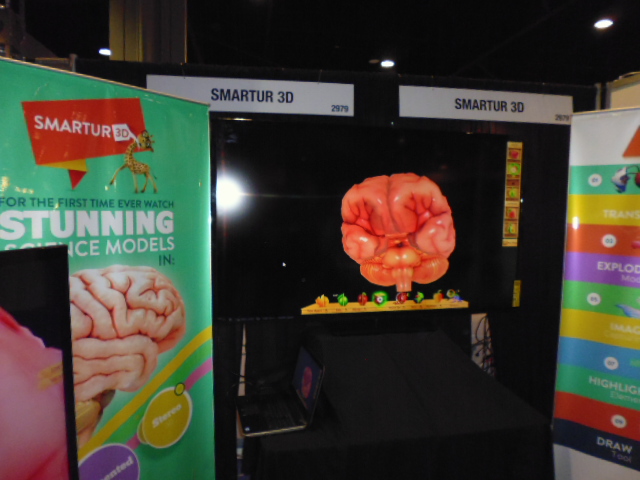3D in Education – To date we have counted 33 major software producers of stereo 3D educational content, worldwide. Now there are 34. A new arrival to the 3D educational software scene, Smartur3D, turned some heads at the recent ISTE conference and is raising the ante for educational 3D with both their unique educational value proposition and marketing plan.

Smartur3D produces interactive 3D models in elementary and secondary level STEM subjects, with other subjects (i.e. geography) coming in the future. Smartur3D currently offers 150 models in Biology; Chemistry and Physics titles are also planned for release in the coming quarter.
These interactive 3D models can be viewed and manipulated in flexible formats: in high-definition rendered 3D, stereo 3D, or even as an augmented reality overlay. Looking at the navigation menu, I immediately recognized that this content was built on the Unity game engine, offering some familiar commands and features (e.g. explode, disassemble, ‘glassy’ transparent mode, hiding elements and reset). But that’s where the similarity stops and the Smartur3D advantage (educational value proposition) comes into play. More advanced capabilities are offered, richer than what we have seen with the typical ‘exploratory’ nature of most 3D interactives. For example, students can label elements as opposed to the computer doing it; elements can be highlighted; a drawing tool enables annotation of elements; and a customization toolbar allows for personalized navigational choices.
 Smartur3D at ISTE 2014
Smartur3D at ISTE 2014
There are other very powerful differentiators as well, features that set Smartur3D apart from the crowd. Some of these attention-getting features include on-the-fly image capture, recording of interactive events for lecture creation or re-showing in a later class. (The teacher can build an animation, annotate it, record what he/she is doing and saying, title it—and then save it for later replay.) Smartur3D also permits overlaying augmented reality images on live video. It is this last capability that I want to spend some time explaining. Only one other company has merged the stereo 3D and the augmented reality worlds effectively —zSpace. Smartur3D is raising the ante by letting the educator take a 3D object from a 3D model and place it in the real world as an augmented reality overlay. It’s quite attention getting. (Think of it as embedding an augmented reality object in a live video feed of your own classroom of students, while they are watching.)
Another advantage offered by Smartur3D is simplicity and flexibility in installation. These are not small matters, as over-complexity and technical constraints become deal breakers for many schools. Smartur3D can be installed via a CD or network, put on high-end or low-end laptops or computers, and even displayed on projectors, 3D displays, or interactive white boards.
Since cost makes or breaks technology use for schools, Smartur3D is also innovating in this space. “We wanted a price point that even [emerging markets] could afford”, explained Neeraj Jewalkar, CEO of Smartur3D. The price of the entire Smartur3D corpus for an entire school (not just one teacher), regardless of the size of school is $99 per year, per school. “The whole idea is to create something that is affordable”, adds Jewalkar. “And despite the fact that it is already affordable, we are going to give away the first year of Smartur3D for free for a whole year for anyone who signs up”.

With an eye for continuous improvement, Smartur 3D is also developing Android and iOS versions of their software, due to be released in early 2015. That being said, some of the basics still need attention: Smartur3D could benefit from more ancillary materials (teachers want support materials), more content titles, better stereoscopy (I see some image ghosting), and a well-defined training offering. But any way you look at it, Smartur3D is raising the ante in educational 3D. –Len Scrogan

